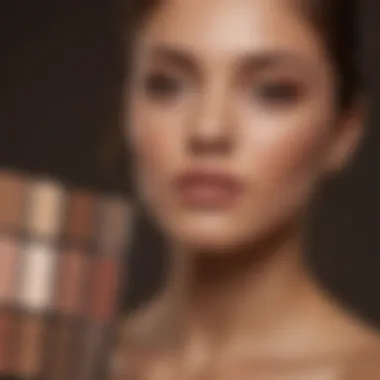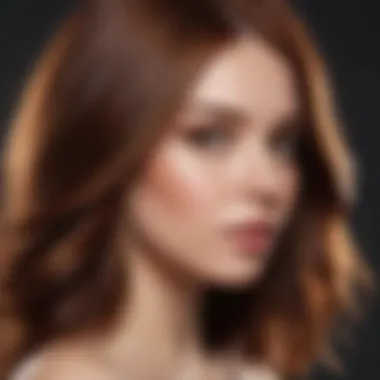Perfect Hair Colors for Brown Skin Tones


Intro
Choosing the right hair color is pivotal not only for enhancing one's appearance but also for expressing individuality. For women with brown skin, selecting a hair color that complements their skin tone can enhance their natural beauty and resonate with their personal style. Understanding color theory, including how different shades interact with various skin undertones, is essential in this process. This guide is designed to provide insights into how to pick hair colors that work harmoniously with brown skin, along with practical maintenance tips and popular trends.
Recognizing the wide spectrum of brown skin tones is paramount. Not every shade works the same for everyone, so examining the subtleties is crucial. There are various undertones found in brown skin—warm, cool, and neutral—which play a vital role in determining which hair colors will appear the most flattering.
The increasing diversity in beauty trends has brought numerous hair color options to the forefront, including vibrant hues and softer shades that can accentuate brown skin beautifully. This article will guide you through current trending topics, detailed fashion styling tips, and advice on how to maintain that new look effectively. By deeply exploring these elements, you can boost your confidence and celebrate your unique features.
Understanding Skin Undertones
Understanding skin undertones is essential for choosing hair colors that enhance brown skin. Undertones are the subtle hues beneath the surface of the skin that influence how colors appear overall. Recognizing these undertones can lead to more satisfying results when selecting a hair shade. When hair colors align with the skin's undertones, they create a harmonious look that elevates personal style.
Importance of Undertones in Color Selection
The significance of undertones in color selection cannot be overstated. Choosing a hair color that matches one’s undertone can make a substantial difference in overall appearance. A compatible shade can bring out natural beauty, accentuate facial features, and even make skin appear healthier. For individuals with brown skin, identifying the right undertone will aid in choosing shades of hair dye that flatter rather than clash with their complexion.
Key Benefits of Matching Hair Color with Undertones:
- Enhances natural glow
- Complements skin tone
- Boosts confidence and satisfaction
Identifying Warm vs. Cool Undertones
Understanding warm versus cool undertones is a critical part of this process. Warm undertones usually have hints of gold, yellow, or peach in their complexion. Common indicators include:
- Veins appear greenish
- Skin tans easily
- Gold jewelry looks more flattering
In contrast, individuals with cool undertones often have traces of pink, red, or blue. Signs of cool undertones might be:
- Veins appear bluish
- Complexion burns rather than tans
- Silver jewelry tends to look better
Identifying your undertone can guide you in selecting hair colors that bring out your best attributes.
Neutral Undertones: Finding Balance
Those with neutral undertones have a balanced mix of warm and cool tones. This type can wear a variety of colors, as they do not lean strongly towards either category. However, it is still essential to be cautious when selecting hair colors. Neutral undertones benefit from:
- Shades that combine both warm and cool tones, such as caramel or chestnut.
- Avoiding colors that are too vibrant or saturated, as they might overwhelm the complexion.
In summary, understanding undertones is a cornerstone to making informed hair color choices. It allows women with brown skin to express their individuality while ensuring their hair colors provide a flattering effect.
Natural Hair Color Spectrum
Understanding the natural hair color spectrum is essential for choosing the right shades for brown skin. Natural hair color reflects not only personal style but also the underlying pigments present in the hair. It can significantly influence how certain colors appear on an individual. Knowing these elements can aid in making informed choices that enhance one's natural beauty.
The natural hair color spectrum includes a variety of shades from light blondes to deep blacks, including browns, reds, and auburns. Emphasizing this spectrum is crucial since it provides a foundational understanding of how hair color interacts with skin tone and undertones. For example, warm skin tones generally pair well with golden or red hues, while cool skin tones favor ashy or muted tones. Thus, recognizing where one's natural color lies can better inform the selection of dye options.
Reviewing Common Natural Shades


There are various common natural shades that women often have. These include:
- Black: Deep and rich, often enhances the glow of brown skin while highlighting features.
- Chocolate Brown: A warm shade that complements yellow and red undertones well.
- Auburn: A mixture of brown with red elements, it can enliven the complexion beautifully.
- Honey Blonde: Provides a warm brightness, especially suitable for women with neutral or warm undertones.
- Ash Brown: This color carries cool undertones, making it appropriate for cool-toned individuals.
These shades can serve as a reference point when considering hair color changes. Evaluating these common shades helps in understanding the preferred tones that resonate with one's aesthetic.
How Natural Color Influences Choices
Natural hair color acts as a guide for selecting hair dyes and treatments. It directly affects how new colors will manifest when applied. For instance, someone with naturally dark hair might see different results when coloring with lighter shades like platinum blonde compared to someone with already lighter hair.
- Adaptability: Darker shades might require pre-lightening for vibrant colors or pastels to show effectively. This could lead to potential damage if not managed correctly.
- Contrast and Harmony: When choosing hair colors, one should consider the contrast with their skin tone. A simple color can create a harmonious look while a stark contrast can make a statement.
- Maintenance: Darker hues may mask the commitment required with lighter colors, which tend to show roots sooner. Knowing one’s natural shade can influence how often color touch-ups are needed.
Natural hair color significantly lays the groundwork for making suitable choices that highlight the features of brown skin. It encompasses an understanding of how others perceive color and its effects on personal image. As such, being mindful of these elements ensures that the choices made are not only aesthetically pleasing but also complementary.
Recommended Hair Colors for Brown Skin
Choosing the right hair color for brown skin is not just about aesthetics; it is a reflection of personal identity and style. Understanding how different colors can enhance your natural features is essential. Among the many considerations, the undertones of your skin, how the hair color relates to your overall look, and even the impact on your mood and confidence come into play. This section will explore various recommended hair colors that complement brown skin, focusing on the vibrancy and depth they can bring.
Deep and Rich Shades
Deep and rich shades serve as a striking complement to brown skin tones. Colors like deep burgundy, mahogany, and espresso create a beautiful contrast that highlights the warmth inherent in brown skin. These shades add depth and texture. Moreover, they tend to be low maintenance, which can be a significant factor for many.
When considering these rich colors, think about how they can enhance your overall appearance. For instance, a deep burgundy not only flatters but also brings out the warmth in your complexion. With careful selection, these hues can elevate your style without requiring frequent touch-ups.
Bright Colors: Making a Statement
Bright colors have the power to transform your look entirely. Vibrant shades like electric blue, cherry red, or bright purple can make a bold statement. These colors often create an eye-catching contrast against brown skin. Choosing such vivid hues allows for expression and individuality. However, it is vital to select shades that resonate with your personality and lifestyle.
One should also consider the impact of bright colors on daily activities. If you are active in social settings or prefer a specific image, brighter colors may have a transformative effect. There’s also the element of fun; these colors can indeed reflect a lively spirit and creativity.
Pastel and Soft Hues: A Delicate Approach
Pastel and soft hues offer a gentler take on hair color for brown skin. Soft pinks, lavenders, and mint greens can bring an ethereal touch, allowing those with brown skin to enjoy a subtle yet chic aesthetic. These shades are often softer, creating an elegant appearance without overwhelming the natural beauty of your complexion.
These colors work particularly well for those interested in a more delicate approach. They often pair beautifully with neutral or earthy tones in clothing. Furthermore, pastels require less commitment as they can fade gently over time. Therefore, they are a suitable choice for those who prefer to keep their options open.
Choosing the right shade is more than just a preference; it is a manifestation of personal style.
Specific Shades to Consider
When selecting hair colors for brown skin, delving into specific shades is crucial. This exploration allows individuals to identify tones that not only complement their skin but also align with their personal style. The right shade can enhance features, create harmony, and elevate one's overall image. Understanding these specific shades can lead to more informed choices, helping to avoid colors that may clash or wash out the natural beauty of brown skin.
Burgundy and Copper
Burgundy and copper are two vibrant shades that can work wonders on brown skin. Burgundy, a rich, deep red, offers a bold yet sophisticated look. It serves to create a striking contrast against warmer skin tones, making features pop, especially in natural light. For those with warm undertones, copper adds a stunning glow, enhancing radiance.
In addition, these shades provide versatility. Burgundy can be incorporated in various styles, from full color to balayage. Similarly, copper highlights can add dimension without overwhelming the base color. For maintenance, it's advisable to use color-protecting shampoos and conditioners. Regular treatments can prevent fading, ensuring that these lively shades remain vibrant.
Golden Blonde and Honey Highlights


Golden blonde and honey highlights are not only trendy but also provide an excellent match for brown skin tones. These shades introduce warmth, illuminating the face and ensuring a fresh appearance. When blended with darker base colors, golden blonde and honey can create a beautiful gradient, enhancing depth and texture in the hair.
Individuals with golden blonde may look best if they have warm undertones, while honey highlights are versatile enough to suit both warm and cool skin tones. The integration of these shades can be accomplished through highlights, lowlights, or an all-over dye, depending on one’s desired look. Care routines should involve moisturizing products to combat potential dryness, especially after coloring.
Jet Black and Dark Brown
Jet black and dark brown are classic choices that never go out of style. These shades provide a striking contrast that emphasizes the richness of brown skin. Jet black offers an intense look, often making a strong statement of elegance and sophistication. It's particularly appealing for those desiring a bold appearance or introducing a sleek aesthetic.
Dark brown, on the other hand, is subtly softer while still maintaining richness. It can provide a natural look, blending effortlessly for a more understated glamour. Both shades require regular maintenance to keep hair looking healthy. Using color-safe products is essential to help preserve the depth and shine of these darker colors. Moreover, routine trims will aid in keeping hair in optimal condition, free from split ends.
Important Consideration: Choosing the right shade requires testing. Consider consulting with a professional colorist. They can provide personalized recommendations based on your unique skin tone and hair type.
Factors Influencing Hair Color Choices
Choosing the right hair color is a personal journey influenced by various factors. Understanding these influences helps in making informed decisions. From skin type to lifestyle habits, each aspect plays its role in how your hair color can enhance your overall appearance and express your identity. When you consider these factors, you move closer to finding a color that resonates with who you are.
Skin Type and Hair Health
Your skin type directly affects the health of your hair. Oily skin may lead to a quicker fade of colored hair. On the other hand, dry scalp and hair can struggle to hold dyes well. Therefore, it's crucial to assess your scalp conditions before opting for any color.
- Choosing the right hair product can make a significant difference. For instance, nourishing shampoos infused with essential oils can help maintain moisture, thereby preserving color for longer.
- Additionally, treatments such as weekly masks or scalp scrubs can ensure that the hair remains in optimum condition. Healthy hair showcases color much better than damaged hair.
Remember, achieving the desired hair color also includes regular maintenance practices to keep the hair hydrated and healthy. This preventive care prevents dullness and enhances vibrancy.
Lifestyle Considerations
Your lifestyle plays a crucial role in determining what hair color works best for you. If you lead an active life, bright or adventurous colors may require more frequent touch-ups. Conversely, if you prefer a low-maintenance approach, selecting shades that naturally blend with your hair could be ideal.
- Factors to think through include:
- Your profession: Certain workplaces may have stricter guidelines about hair colors.
- Daily routine: If you have a busy schedule, consider shades that can endure daily wear.
- Commitment level: Reflect on how much time and effort you are willing to dedicate to maintaining your hair color.
Ultimately, finding a balance between personal style and lifestyle is pivotal. Make sure to choose a hair color that aligns with your routine.
Personality and Expression
Your choice of hair color is also a reflection of your personality. A vibrant color can make a bold statement about confidence and creativity. In contrast, subtle tones might communicate sophistication and professionalism. If you find joy in self-expression, selecting a shade that mirrors your true self is essential.
- Think about:
- How your hair color affects your mood: Some colors enhance motivation or relaxation.
- What colors you've worn in the past: Do they resonate with who you feel you are today?
- The image you want to project to others.
"Your hair color is a canvas that illustrates your individuality. Choose wisely, and let it speak for you."
Hair Color Application Methods
Understanding hair color application methods is essential for those aiming to enhance their features through the right hair color. The process of color application can significantly affect the final look and health of the hair. Choosing suitable methods can ensure that the desired shade is achieved while maintaining the integrity of the hair. Knowing the advantages and the potential pitfalls of each approach helps in making an informed decision.


At-Home Dyeing Techniques
At-home dyeing can be a convenient option for those who prefer a more flexible approach. Many women find the appeal in the cost-effectiveness and privacy it offers. However, it is crucial to follow instructions carefully and choose the right products to avoid unexpected results. Here are some essential tips for at-home hair dyeing:
- Preparation is Key: Gather all necessary materials such as gloves, a dye kit, and old towels. Make sure to conduct a patch test to check for allergic reactions.
- Section the Hair: Divide the hair into manageable sections. This technique ensures even application and better coverage.
- Apply Evenly: Start from the roots and work through to the ends. Ensure that the dye saturates the hair thoroughly for uniform color.
- Follow Time Guidelines: Keep track of the recommended processing time. Leaving dye on for too long can lead to unwanted results.
While at-home techniques are practical, they carry the risk of uneven color or damage if not done correctly. Therefore, it’s crucial to assess personal capabilities and perhaps seek professional advice for the best outcomes.
Salon Processes Explained
Salon processes are often preferred by those who desire a professional touch. Expert stylists can provide customized color solutions that at-home methods may not achieve. The precision and expertise found in salons can lead to a more satisfactory result. Here are some factors to consider when opting for salon services:
- Consultation: Before any dyeing occurs, a thorough consultation is vital. This step allows the stylist to assess hair type, current color, and skin undertones to find the best shade.
- Application Techniques: Stylists may use varied techniques including balayage, highlights, or lowlights. Each of these methods can produce different effects and enhance the overall look.
- Professional Products: Salons use high-quality hair products that can minimize damage and produce vibrant colors. The color can last longer, and treatments for damaged hair may also be offered.
"Your hair color is a reflection of your personality. Selecting the right application method can enhance that expression."
Maintenance of Colored Hair
Maintaining colored hair is crucial, especially for those with brown skin. Color-treated hair requires special attention to preserve its vibrancy and health. When hair is dyed, it can experience changes in texture and shine. Therefore, understanding maintenance can prolong the life of the color while keeping the hair luxurious and appealing.
A proper maintenance routine includes using specific products and strategies to reduce fading and damage. Without adequate care, the brilliance of the color can diminish quickly, and hair can become brittle or dry. Thus, it is essential to prioritize this aspect of hair care.
Essential Products for Color Preservation
Choosing the right products is vital for maintaining colored hair. Here is a list of essential items:
- Sulfate-Free Shampoo: Traditional shampoos often contain sulfates that strip natural oils and color from hair. A sulfate-free formula can gently cleanse without fading your color.
- Color-Safe Conditioner: A good conditioner helps to keep hair moisturized. Look for products labeled as color-safe. They often contain ingredients such as argan oil or keratin that aid in locking in color.
- Leave-In Treatments: These products can provide additional moisture and protection against environmental stressors.
- UV Protection Spray: Sun exposure can alter hair color. A UV protection spray can shield colored hair from the sun’s harmful rays.
- Hair Masks: Incorporating a hair mask into your routine can provide deep hydration and repair.
Selecting high-quality products will significantly impact the health and appearance of colored hair.
Routine Care Tips
In addition to using the right products, following a consistent routine can help maintain the integrity of colored hair:
- Wash Less Frequently: Over-washing can lead to color fading. Aim to wash hair two to three times per week.
- Cool Water Rinse: When rinsing hair, use cool or lukewarm water to help seal the cuticle and retain color.
- Limit Heat Styling: Excessive heat can damage hair further. When using heat tools, apply a heat protectant spray.
- Trim Regularly: Regular trims can prevent split ends and promote overall hair health.
- Protect During Sleep: Using a silk or satin pillowcase can reduce friction during sleep, minimizing damage to styled hair.
Following these routine care tips will help in keeping colored hair vibrant and healthy.
Understanding and integrating these maintenance strategies can truly elevate the hair coloring experience for women with brown skin, enhancing their beauty and confidence.
Final Thoughts on Hair Color Choices
Choosing the right hair color for brown skin goes beyond mere aesthetics. It reflects personal identity, style, and cultural nuances. Hair color can significantly influence how a person perceives themselves and how others see them. This article has provided a detailed analysis of various factors that contribute to effective hair color selection. It has explored skin undertones, recommended shades, and the elements of maintenance. The importance lies not just in finding a shade that looks good but also in understanding how that choice can highlight one's features. By weighing various factors, individuals can make choices that resonate well with their personality.
Emphasizing Personal Style
Personal style is an essential component of one's identity. Hair color plays a crucial role in this. For women with brown skin, selecting a hue that complements their unique features can reinforce their sense of self. Personal style is not just about clothing or accessories; it extends to hair. By opting for vibrant colors or subtle highlights, individuals can express their individuality clearly. Consideration of hair texture, length, and face shape also enhances this selection process. Each choice should reflect who the individual is, allowing for the creation of a coherent personal brand.
Confidence Through Color Selection
Confidence can be deeply influenced by appearance, and hair color is a significant factor in this equation. Selecting the right hair color empowers women to feel more self-assured. When a shade suits someone's skin tone, it not only looks better but can also enhance one's overall presence. A well-chosen color can uplift mood and foster a sense of well-being. On the other hand, a poor match might detract from one's natural beauty.
It is essential to experiment within the comfort limits. Trying out various shades can lead to discovering what truly resonates with one's identity. Remember, the key is to choose a color that feels authentic, which can ultimately bolster confidence.
"The right hair color doesn’t just beautify; it transforms your entire outlook."



